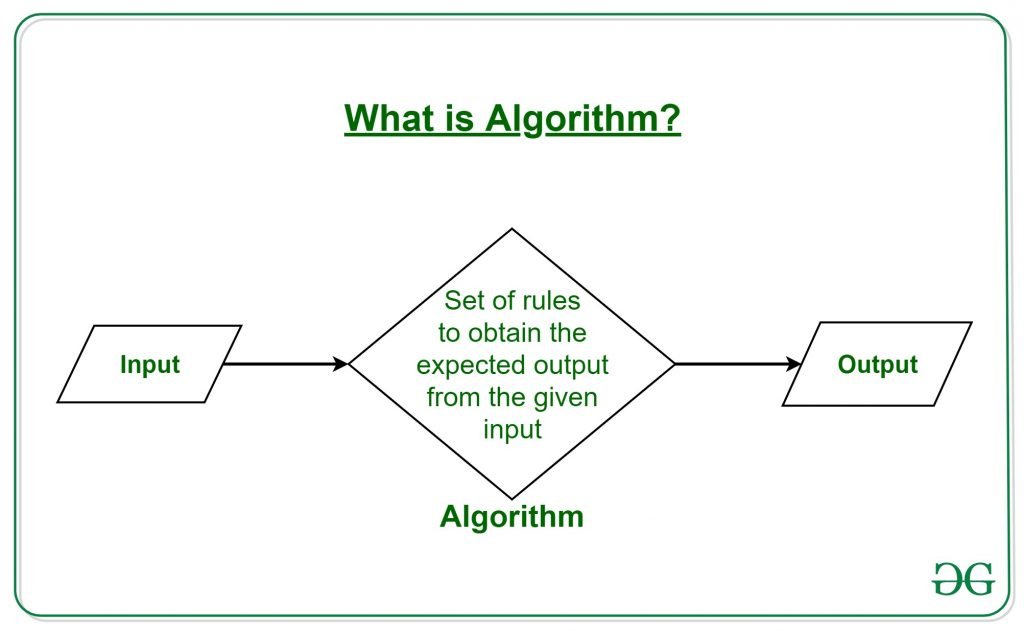 Blog's Page
Blog's Page

An Algorithm Is A Set Of Well-defined Instructions Or Steps That Specify How To Perform A Task Or Solve A Specific Problem. It Is A Step-by-step Procedure For Solving A Problem Or Accomplishing A Specific Task, And Is Typically Expressed In A Programming Language Or Mathematical Notation.
An Algorithm Is Characterized By Its Input And Output, And The Sequence Of Steps It Performs To Transform The Input Into The Output. It Must Be Unambiguous, And Its Steps Must Be Effective And Terminate After A Finite Number Of Steps. Algorithms Are Used In Many Areas, Including Computer Science, Mathematics, Engineering, And Cryptography.
Some Common Examples Of Algorithms Include Sorting Algorithms, Such As Quicksort Or Mergesort, And Search Algorithms, Such As Binary Search Or Linear Search. Algorithms Can Also Be Used For Complex Tasks, Such As Finding The Shortest Path Between Two Points In A Network, Or For Solving Problems In Cryptography, Such As Encryption And Decryption.
An Algorithm Works By Taking In Inputs, Processing The Data According To A Set Of Rules, And Producing An Output. The Steps Involved In The Algorithm Can Be Expressed In A Programming Language, A Flowchart, Or A Written Description.
Here Is A High-level Overview Of How An Algorithm Works:
Input: The Algorithm Receives Input Data, Which May Be In The Form Of Numbers, Strings, Images, Or Any Other Type Of Data.
Processing: The Input Data Is Processed According To The Set Of Rules Specified In The Algorithm. This May Involve Performing Mathematical Operations, Making Decisions Based On Conditions, And Manipulating Data Structures.
Output: The Processed Data Is Then Transformed Into An Output, Which May Be In The Form Of A Result, An Action, Or A Transformed Data Structure.
The Specific Steps Involved In An Algorithm Will Vary Depending On The Problem It Is Designed To Solve. However, The Basic Idea Is That The Algorithm Takes In Data, Performs A Series Of Operations On That Data, And Produces An Output.
It Is Important To Note That Algorithms Can Be Used To Solve Problems In Many Different Domains, And The Steps Involved In Each Algorithm Will Differ Depending On The Specific Problem. Additionally, Some Algorithms Are Designed To Run Efficiently, While Others May Take Longer To Run But Provide More Accurate Results.
Algorithms Have Several Advantages, Including:
Efficiency: Algorithms Can Perform Complex Tasks In A Systematic And Efficient Manner, Reducing The Amount Of Time And Resources Needed To Solve A Problem.
Repeatability: Algorithms Can Be Repeated Over And Over Again, Providing Consistent Results Each Time.
Accuracy: Algorithms Can Produce Accurate Results, Free Of Human Error, Providing Greater Confidence In The Results.
Objectivity: Algorithms Are Not Subject To Personal Biases Or Interpretations, Making Them Suitable For Use In Areas Such As Financial Analysis, Scientific Research, And Decision-making Processes.
Automation: Algorithms Can Be Automated, Reducing The Need For Manual Labor And Freeing Up Human Resources For Other Tasks.
Scalability: Algorithms Can Be Easily Scaled Up Or Down, Depending On The Size Of The Problem And The Available Resources, Making Them Suitable For Use In A Wide Range Of Applications.
Optimization: Algorithms Can Be Used To Optimize Problems, Such As Finding The Shortest Path In A Network Or Minimizing Energy Consumption In A System.
Overall, Algorithms Provide A Systematic, Efficient, And Objective Way Of Solving Problems, Which Can Be Particularly Useful In Areas Where Time, Accuracy, And Objectivity Are Critical.
Algorithms Also Have Some Disadvantages, Including:
Limitations Of The Algorithm: Algorithms Are Limited By Their Design And Can Only Perform The Specific Tasks They Were Designed For. They May Not Be Able To Handle New Or Unexpected Data Or Changes In The Problem They Are Solving.
Bias And Discrimination: Algorithms Can Perpetuate Or Amplify Existing Biases And Discrimination If They Are Trained On Biased Data Or If The Algorithms Themselves Are Designed With Built-in Biases.
Lack Of Transparency: The Inner Workings Of Some Algorithms Can Be Difficult To Understand Or Explain, Making It Difficult To Determine Why A Certain Result Was Produced.
Lack Of Creativity: Algorithms Are Not Capable Of Generating New Ideas Or Innovations In The Same Way That Humans Can.
Dependence On Technology: The Reliance On Algorithms Can Lead To A Loss Of Critical Thinking And Problem-solving Skills If Humans Rely Too Heavily On The Technology.
Job Displacement: Automation Through Algorithms Can Displace Workers In Certain Industries, Leading To Job Loss And Economic Disruption.
Overall, While Algorithms Have Many Advantages, It Is Important To Carefully Consider Their Limitations And Potential Consequences Before Using Them To Solve Problems. It Is Also Important To Continuously Monitor And Evaluate The Performance Of Algorithms To Ensure That They Are Fair And Unbiased, And To Make Adjustments As Necessary.